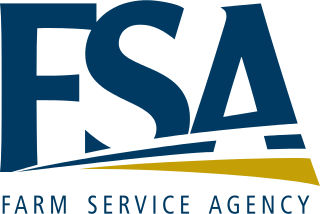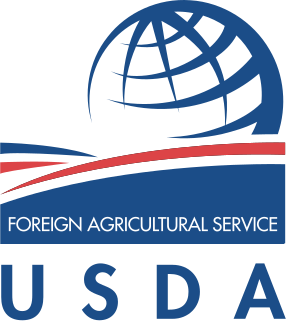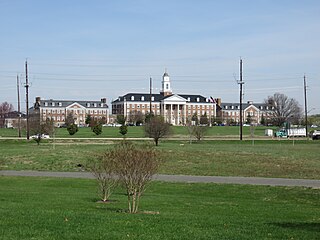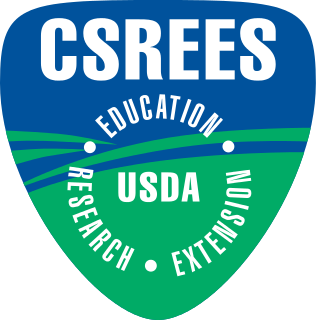Related Research Articles

The United States Secretary of Agriculture is the head of the United States Department of Agriculture. The Secretary of Agriculture is former Georgia Governor Sonny Perdue. Perdue took office on April 25, 2017 after being confirmed by the U.S Senate 87-11. The position carries similar responsibilities to those of agriculture ministers in other governments.

The United States Department of Agriculture (USDA), also known as the Agriculture Department, is the U.S. federal executive department responsible for developing and executing federal laws related to farming, forestry, and food. It aims to meet the needs of farmers and ranchers, promote agricultural trade and production, work to assure food safety, protect natural resources, foster rural communities and end hunger in the United States and internationally.

The Agricultural Research Service (ARS) is the principal in-house research agency of the United States Department of Agriculture (USDA). ARS is one of four agencies in USDA's Research, Education and Economics mission area. ARS is charged with extending the nation's scientific knowledge and solving agricultural problems through its four national program areas: nutrition, food safety and quality; animal production and protection; natural resources and sustainable agricultural systems; and crop production and protection. ARS research focuses on solving problems affecting Americans every day. The ARS Headquarters is located in the Jamie L. Whitten Building on Independence Avenue in Washington, D.C. and the headquarters staff is located at the George Washington Carver Center (GWCC) in Beltsville, Maryland. For 2018, its budget was $1.2 billion.

The Animal and Plant Health Inspection Service (APHIS) is an agency of the United States Department of Agriculture (USDA) based in Riverdale, Maryland responsible for protecting animal health, animal welfare, and plant health. APHIS is the lead agency for collaboration with other agencies to protect U.S. agriculture from invasive pests and diseases. APHIS is the National Plant Protection Authority for the U.S. government, and the agency's head of veterinary services is Chief Veterinary Officer of the United States.

The Farm Service Agency (FSA) is the United States Department of Agriculture agency into which were merged several predecessor agencies, including the Agricultural Stabilization and Conservation Service (ASCS). The ASCS was, as the FSA is now, primarily tasked with the implementation of farm conservation and regulation laws around the country. The Administrator of FSA reports to the Under Secretary of Agriculture for Farm and Foreign Agricultural Services. The current Acting Administrator is Chris Beyerhelm. The FSA (ASCS) of each state is led by a politically appointed State Executive Director (SED).

The Supplemental Nutrition Assistance Program (SNAP), formerly known as the Food Stamp Program, provides food-purchasing assistance for low- and no-income people living in the United States. It is a federal aid program, administered by the United States Department of Agriculture, under the Food and Nutrition Service (FNS), though benefits are distributed by each U.S. state's Division of Social Services or Children and Family Services.
Natural Resources Conservation Service (NRCS), formerly known as the Soil Conservation Service (SCS), is an agency of the United States Department of Agriculture (USDA) that provides technical assistance to farmers and other private landowners and managers.
The National Organic Program (NOP) is the federal regulatory framework in the United States of America governing organic food. It is also the name of the United States Department of Agriculture (USDA) Agricultural Marketing Service (AMS) program responsible for administering and enforcing the regulatory framework. The core mission of the NOP is to protect the integrity of the USDA organic seal. The seal is used for products adhering to USDA standards that contain at least 95% organic ingredients.

Quality Assurance International (QAI) is a U.S.-based international organic certification company that is authorized by the United States Department of Agriculture (USDA) as "a USDA-accredited certifying agent that operates globally to certify organic operations to National Organic Program standards." It is a for-profit corporation, established in 1989, and headquartered in San Diego, California. It is one of the world's largest certifiers, operating in the United States, Canada, Latin America, European Union, and Japan. It is owned by public health and environmental organization NSF International.

The Foreign Agricultural Service (FAS) is the foreign affairs agency with primary responsibility for the United States Department of Agriculture's (USDA) overseas programs—market development, international trade agreements and negotiations, and the collection of statistics and market information. It also administers the USDA's export credit guarantee and food aid programs and helps increase income and food availability in developing nations by mobilizing expertise for agriculturally led economic growth. In 2003, FAS began to return to a long-abandoned role in national security. The FAS mission statement reads, "Linking U.S. agriculture to the world to enhance export opportunities and global food security", and its motto is "Linking U.S. Agriculture to the World".
The Commodity Credit Corporation (CCC) is a wholly owned United States government corporation that was created in 1933 to "stabilize, support, and protect farm income and prices". The CCC is authorized to buy, sell, lend, make payments, and engage in other activities for the purpose of increasing production, stabilizing prices, assuring adequate supplies, and facilitating the efficient marketing of agricultural commodities.

The Henry A. Wallace Beltsville Agricultural Research Center (BARC), also known as the National Agricultural Research Center, is a unit of the United States Department of Agriculture's Agricultural Research Service. It is located at 39°02′N76°53′W in unincorporated Prince George's County, Maryland, with sections within the Beltsville census-designated place. The BARC is named for Henry A. Wallace, former United States vice president and secretary of agriculture. BARC houses the Abraham Lincoln Building of the National Agricultural Library.

The Under Secretary of Agriculture for Farm and Foreign Agricultural Services was the third-ranking official in the United States Department of Agriculture prior to reorganization of several mission areas, announced on May 11, 2017. The mission area of USDA's purpose was to "help to keep America's farmers and ranchers in business as they face the uncertainties of weather and markets..." and that "...deliver[s] commodity, credit, conservation, disaster, and emergency assistance programs that help improve the stability and strength of the agricultural economy." The Under Secretary was traditionally appointed to serve as the President of the Commodity Credit Corporation.
Organic beef is beef grown according to organic food principles.

The Climate Prediction Center (CPC) is a United States federal agency that is one of the National Centers for Environmental Prediction, which are a part of the National Oceanic and Atmospheric Administration's National Weather Service. CPC is headquartered in College Park, Maryland. Its roots trace back to the late 18th century, with the United States Army Signal Corp taking over responsibility of the climate program in the late 19th century. Once it became part of the United States Weather Bureau, it was known as the Weather Bureau Climate and Crop Services. From 1957 through 1966, the United States Weather Bureau's Office of Climatology, located in Washington, D.C. and then Suitland, Maryland, published the Mariners Weather Log publication. Late in the 20th century, it was known as the Climate Analysis Center for a time, before evolving into CPC in 1995. CPC issues climate forecasts valid for weeks and months in advance.

The Food, Agriculture, Conservation, and Trade (FACT) Act of 1990 — P.L. 101-624 was a 5-year omnibus farm bill that passed Congress and was signed into law.
The Joint Agricultural Weather Facility (JAWF), created in 1978, is a cooperative effort between USDA’s World Agricultural Outlook Board and the National Oceanic and Atmospheric Administration of the U.S. Department of Commerce to collect, on an ongoing basis, global weather data and agricultural information to determine the impact of weather conditions on crop and livestock production. JAWF reports are followed closely not only by producers but also by commodity traders.
The National Agriculture Imagery Program (NAIP) acquires aerial imagery during the agricultural growing seasons in the continental United States. It is administered by the USDA's Farm Service Agency (FSA) through the Aerial Photography Field Office (APFO) in Salt Lake City.
The Healthy, Hunger-Free Kids Act of 2010 is a federal statute signed into law by President Barack Obama on December 13, 2010. The bill is part of the reauthorization of funding for child nutrition. The bill funds child nutrition programs and free lunch programs in schools for the next 5 years. In addition, the bill sets new nutrition standards for schools, and allocates $4.5 billion for their implementation. The new nutrition standards have been a point initiative of First Lady Michelle Obama in her fight against childhood obesity as part of her Let's Move! initiative. In FY 2011, federal spending totaled $10.1 billion for the National School Lunch Program. The Healthy, Hunger-Free Kids Act allows USDA, for the first time in 30 years, opportunity to make real reforms to the school lunch and breakfast programs by improving the critical nutrition and hunger safety net for millions of children. Healthy, Hunger-Free Kids Act and Michelle Obama were a step in transforming the food pyramid recommendation, which has been around since the early 1990s, into what is now known as "MyPlate".

The Cooperative State Research, Education, and Extension Service (CSREES) is an extension agency within the U.S. Department of Agriculture (USDA), part of the executive branch of the federal government. The 1994 Department Reorganization Act, passed by Congress, created CSREES by combining the former Cooperative State Research Service and the Extension Service into a single agency.
References


The Congressional Research Service (CRS), known as Congress's think tank, is a public policy research arm of the United States Congress. As a legislative branch agency within the Library of Congress, CRS works primarily and directly for Members of Congress, their Committees and staff on a confidential, nonpartisan basis.